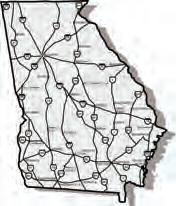











Construction on the Interstate 75 at Akers Mill Road New Express Lanes Ramp project in Cumberland, Ga., got started in 2021.
By Irwin Rapoport
C.W. Matthews Contracting Co. Inc. has delivered the Georgia Department of Transportation’s (GDOT) $26.5 million Interstate 75 at Akers Mill Road New Express Lanes Ramp project in the city of Cumberland (Cobb County), an initiative that began in October 2021.
The project provides motorists with new access to and from Akers Mill Road at I-75 and the I-75/Interstate 575 Northwest Corridor Express Lanes.
Crews achieved open-to-traffic status on Jan. 24, 2025, for the Northwest Corridor’s 12th and newest access point and, like the others, is improving mobility and trip-time reliability facilitating direct flow to and from the Cumberland Community Improvement District (Cumberland CID), a major commercial and residential activity center.
The ramp serves southbound express lane users as an exit in the mornings and northbound express lane users as an entrance in the evenings.
The project began approximately 400 ft. south of the existing Akers Mill Bridge over I-75 and ends approximately 275 ft. south of the existing Windy Ridge Parkway Bridge over I-75.
page 8


Savannah, Ga.’s Historic District Board of Review (HDBR) narrowly approved the height and mass of a proposed 6-story mixed-use building May 14, 2025, on the corner of Oglethorpe Avenue and Drayton Street, the Morning News reported.
The project architects reduced the building’s height by 5 ft. and added a setback on its western facade to make a portion of the building’s mass more visually compatible with the neighboring Ballastone Inn and other nearby structures.
The approval came on a slim 4-3 vote after extensive public opposition to the proposal.
“I think the modifications have made the project much better and are fully in compliance with the guidelines,” said project designer Andrew Lynch of Lynch Associates Architects in Savannah.
The petition has received more than 90 online public comments — overwhelmingly against the project — and another roughly 10 individuals showed up in opposition at the May 14 meeting.
Savannah HDBR’s approval of visual compatibility was made despite existing contributing structures on the project’s block of East Oglethorpe Avenue, such as the Julliette Gordon Low House and Ballastone Inn, each having five or fewer floors and residentialscale building footprints.
The port city’s ordinance regulating design within its Downtown Historic District states visual compatibility should be judged by structures within view of the subject property.

Lynch Associates Architects image
The project architects reduced the building's height by 5 ft. and added a setback on its western facade to make a portion of the building’s mass more visually compatible with the neighboring Ballastone Inn and other nearby structures.
Opponents of the project included Juliette Gordon, Low Birthplace Museum Executive Director Shannon BrowningMullis and two architects of the Ballastone Inn. Each of those public commenters said members of the project’s development team did not meet with them about the building’s size.
“The visual compatibility is a real issue to us,” said Reggie Gibson, who said he was an architect on the neighboring property. “... so, the only thing I can think to say is the building is too big, too tall and too flat.”
Proponents of the building’s construction pointed to the Savannah-Chatham County Public School’s Board of Education building across Oglethorpe Avenue and the Savannah College of Art and Design’s Bradley Hall as examples of comparably sized buildings within view of the project site.
The project, currently dubbed the Oglethorpe Residences, was designed to feature ground-floor commercial use and residences on the second through sixth floors. The property resides in a five-story-height map zone, but a bonus is available based on the ground floor being used as commercial, according to the Morning News.
But HDBR’s approval was just the first of two that are required before construction can get under way. Further design elements such as building materials are to be used will go before HDBR at a future meeting.
The board’s vote featured unique circumstances in that new members were appointed to the HDBR since the project’s first hearing. One new member, Mariel Hamer, recused
herself from the vote due to a conflict of interest; she is a project designer of Lynch Associates Architects.
Another new member, Robert Helms, publicly opposed the project as a private citizen during a February 2025 meeting. Helms told his fellow members that he did not believe he needed to recuse himself over a conflict of interest and affirmed his ability to judge the petition objectively based on the city’s ordinance.
In the end, though, he voted to deny the project.
“I have no personal stake in this one way or the other, except that I think it’s visually incompatible with what is around it,” Helms said.
A $70 million renovation project was approved for the Georgia Institute of Technology’s Bobby Dodd Stadium at a May 15, 2025 meeting of the University System of Georgia’s Board of Regents.
Now, the Georgia Tech Athletic Association will have to secure funding and financing for the project, noted WSB-TV in Atlanta.
According to the agenda item for the project, Georgia Tech will be in charge of upgrading the stadium, with a stated goal of “determining the best approaches to addressing deficiencies in the current structure,” while also giving more value and a better experience to football fans, alumni and students.
The project proposes adding a variety of features, including premium seating areas on the west sideline, as well as
chairback seating along the entire east and west sidelines “to elevate the game day experience.”
The west sideline also would get eight new founder’s suites, in addition to the same number of new elevated suites and improvement to the 16 existing suites. Press operations and food services locations would be renovated as well, WSB-TV reported.
The proposal also mentions plans for changes on the east sideline, including renovations to 15 suites, an updated Field Club lounge and a new Speakeasy Club, taking up 20,000 sq. ft. and 3,250 sq. ft., respectively.
Other work on Bobby Dodd Stadium would include:
• upfitting 10 suites in the north end zone;
• carrying out renovations on the upper level of the Wardlaw building at the south end zone, which would mean upgrading three suites. University officials also want to relocate the press operations area and add booths for security, radio, statistics and flexible use;
• installing new chairbacks to general admission seating throughout the bowl, except in student areas;
• making changes to address Americans with Disabilities Act (ADA) access needs;
•adding handrails on various sections of the stadium; and
• erecting new videoboards in the south end and northwest corner of the arena.
The Georgia Tech Athletic Association would secure bonds or private financing to cover the project’s costs, according to the proposal text, with construction overall expected to be approximately $39.6 million, along with an additional $18 million for equipment.









After 150 years without a defined downtown, the city of Doraville in metro Atlanta is preparing to begin a transformative new development that will create a long-awaited city center.
Doraville officials said that the development also aims to establish a vibrant, walkable downtown area for the community.
The project took a major step forward when the city signed contracts with its newest partners, Choate Construction Co. and McMillan Pazdan Smith Architecture — both of which are based in Atlanta — to bring the project to life.
Construction is set to break ground begin in June 2025, at a site located on Park Avenue between New Peachtree Road and Buford Highway, not far from the Doraville MARTA transit station, WSB Radio in Atlanta reported May 16, 2025
The site currently houses City Hall and the Doraville Police Department, which will be temporarily relocated to nearby Van Fleet Circle during the construction.
Spanning 13 acres, the new Doraville City Center will serve as a vibrant and inclusive hub designed for all who live, work and visit the community, according to an announcement on the town’s website.
Once complete in the autumn of 2026, the voter-approved development project is being funded through a bond referendum and will feature:
• modern city services building;
• a brand new public library;
• collaborative creator space;
• a centrally located community park; and
• enough extra space for future multifamily housing, retail and dining options.
With community and sustainability at its core, the planned redevelopment will reflect Doraville’s unique spirit and diversity while providing a dynamic space to gather, connect and thrive.
“The Doraville City Center is the culmination of more than 20 years of community visioning, planning,and dialogue,” Mayor Joseph Geierman said in a statement from his office. “This project represents a true investment in the future that reflects the values and aspirations of our residents.”
The highly-regarded Choate Construction brings decades of expertise and a client-first approach, the city noted, while McMillan Pazdan Smith, known for its impressive civic design work, will shape the City Center’s architectural identity.
“The signing of these contracts marks a pivotal step in one of the [city’s] most significant capital projects in decades,” said Chris Eldridge, Doraville’s city manager. “This City Center will not only centralize essential services in a more efficient and accessible way but also create a vibrant gathering place that reflects the energy and diversity of Doraville while supporting future growth.”
Construction officially got under way in mid-May 2025, on the Bells Ferry Road widening project near the city of Woodstock in Cherokee County, on the northwestern edge of Atlanta.
The Georgia Department of Transportation (GDOT) awarded Atlanta’s Astra Group LLC the $37.2 million contract in January 2025, following years of designing, planning and securing the necessary funds to broaden Bells Ferry Road from two to four lanes.
“It’s a been a long road to [get] to this point,” said GDOT District Engineer Grant Waldrop. “We’re moving dirt now and that means we’re on the way to seeing Bells Ferry expanded to fit the growing needs of the area.”
Cherokee County used Georgia’s Special Purpose Local Option Sales Tax (SPLOST) funds, totaling $18.3 million, to acquire all of the right of way and required easements necessary to expedite construction on the road project. The acquisition included 135 parcels of land, according to GDOT.
The contract calls for Bells Ferry Road to be widened beginning on its south end at Southfork Way and ending near Victoria Road, approximately 2.4 mi. to the north.
Some intersections along the route will be converted to Reduced Conflict U-Turns, or RCUTs, which prevent traffic on side roads from turning left or crossing a main road at the intersection. Motorists instead will turn right and then be permitted to make a U-turn at the next break in the roadway’s median.
The transportation agency said RCUTs eliminate dangerous crossings that can result in severe crashes.
Along with expanding Bells Ferry Road to four lanes, the project also will add a multi-use sidewalk and improve visibility on curves leading into intersections with traffic signals.
Contractors began work May 19, 2025, on the city of Thomasville, Ga.’s Remington Avenue Streetscape Project.
The first phase of the $5.1 million effort is designed to provide much-needed improvements to the portion of the corridor stretching along Remington Avenue and East Pinetree Boulevard to the intersection of Kern Street and Smith Avenue.
The Thomasville City Council awarded the construction project to The Scruggs Company in Waycross, Ga., in mid-January 2025, the Times Enterprise reported May 1, 2025.
The current phase one scope will include:
• improvements to the corridor’s water, stormwater and wastewater systems;
• milling and resurfacing the entire roadway within the project’s footprint;
• reducing the road width and adding sidewalks on both sides of Kern Street between Smith Avenue and Reid Street;
• adding a roundabout at the intersection of Kern, Reid and Remington Avenue;
• installing a three-way signalized light at Covington Avenue;
• building a new Butler-Mason YMCA driveway; and
• constructing a concrete median in the lane section of Remington Avenue near East
Pinetree Boulevard.
“We are extremely excited to move this long-awaited project into the construction stage,” Thomasville City Manager Chris White told the Times-Enterprise. “Public input and visioning sessions for the Remington Project date back to 2018. Unfortunately, the COVID-19 pandemic, inflation and other variables have delayed and altered the scope of this project. We are proud of the important features being addressed in phase one of this vital project for one of our most traveled roadways.”
According to Mark Harmon, Thomasville’s executive director of engineering and inspections, the public feedback provided city planning officials with muchneeded information regarding the community’s desire for roadway improvements.
“Phase one will primarily address roadway safety, infrastructure improvements and street paving issues,” he said. “A reduction of the road width at the intersection of Kern Street and Smith Avenue, along with the addition of a concrete median in the fivelane section of the Remington Avenue and East Pinetree Boulevard intersection, will greatly improve roadway safety and flow of traffic. The addition of a three-way signalized light at the Remington Avenue and
Covington Avenue intersection will also assist with speed reduction.”
Regarding the addition of a roundabout at the intersection of Kern Street, Reid Street and Remington Avenue, Harmon characterized that component as another major phase in the overall streetscape project.
“We expect the construction of the proposed roundabout to require a significant amount of time to complete,” he told the Thomasville newspaper. “According to the Georgia Department of Transportation, roundabouts provide a reduced speed environment and offer substantial safety advantages and excellent performance in terms of traffic flow.”
Each of the city’s major building initiatives include a focus on improving aging infrastructure, Harmon said.
“The entire [Remington Avenue] project area will receive much needed water and wastewater system improvements,” Harmon said. “Once we have addressed infrastructure upgrades and the roundabout is completed, the entire project area will be milled and resurfaced.”
Early projected costs for the corridor’s improvements were approximately $9 million before ballooning at one point to more than $22 million.
Harmon explained that city residents coveted a number of roadway features such as safe pedestrian access, traffic calming to control speed, landscaping and road surfacing.
“However, as the project scope expanded and inflation driven by the COVID-19 pandemic significantly increased costs, the city had to reassess what was financially feasible while addressing features important to the project and community,” he said.
The Times-Enterprise noted that in the end, phase one of the Remington Avenue Streetscape Project is primarily being funded through 2018 SPLOST revenues.
Thomasville municipal officials plan to address additional community priorities, such as sidewalks along Remington Avenue from the roundabout to East Pinetree Boulevard, in future phases of the project.
“Weather permitting, we anticipate this project to be completed in 300 days,” said White. “While we do expect temporary road and lane closures and additional detours, we are confident that the coordinated efforts between all parties will minimize the inconveniences created for our citizens and provide a safer and enhanced corridor for both motorists and pedestrians.”














are just a few of the safety feature
Your choice of a sealed or pressurized cab is equipped with system, adjustable wrist rests and a suspension seat to help comfortably all day long. Controls are easy to use, and the i monitor provides customizable machine operator preferenc information.
Maneuvering on the jobsite is even easier with the Cat Stick traditional travel controls with levers and pedal to joystick c button.
an improved air conditioning p keep you working ntuitive Next Generation es and easy to read machine
Increased lifting, swinging and travel and multi-functional pe k Steer option. Switch from controls with a push of a erformance help you get the
Maintenance is quick and easy on access at ground level with group OPERA
with a variable displacement pum es built into the machine. the Cat 306 CR. Routine check poi ped service points and robust servic &
mp, the Cat 306 CR was designed to ints are easy to ce panels. reduce operating
blade, angle blade or Extra Tool C
Contact our dealership today t excavator in the market. arrier (XTC).
to learn more about the newest

Yanmar America has taken a major step toward its sustainability goals with the installation of 914 high-efficiency solar panels at its headquarters in Adairsville, Ga.
As of March 25, 2025, the solar array is fully operational, following successful testing by Georgia Power. This solar array will reduce the facility’s reliance on non-renewable power sources and lower the company’s carbon footprint in line with the Yanmar Green Challenge 2050 goals.
“This solar investment is our first step toward reducing our carbon footprint,” said Yanmar America President, Jeff Albright. “Our commitment to the community and our employees is to be good stewards of the environment and leaders in achieving a zero-carbon footprint.”
According to Yanmar, sustainability has always been a cornerstone of its mission. For more than a century, the company has developed innovative technologies to maximize efficiency while minimizing waste. This commitment extends beyond individual products and services to encom-
pass Yanmar’s broader vision for a sustainable future. To meet the challenges of becoming an ecological footprintfree, GHG-free corporation based on recycled resources, Yanmar has launched the Green Challenge 2050.
This sustainability strategy revolves around three main objectives:
• achieving zero GHG emissions from corporate operations;
• creating zero environmental impact by circulating resources; and
• supporting customers in reducing their GHG emissions and enhancing resource circulation.
These goals drive Yanmar’s investments in advanced technologies, global collaboration and sustainable transformation across its operations and products. Each initiative under the Green Challenge 2050 targets specific sustainability challenges to ensure Yanmar’s continued leadership in the global push for decarbonization.
The solar panel installation in Adairsville is just one exam-
ple of Yanmar’s broader commitment to renewable energy. Similar initiatives are under way at other Yanmar facilities worldwide, including Yanmar Engine Manufacturing India, Yanmar Compact Equipment Europe and Yanmar Europe, the Group’s European headquarters. Each installation plays a vital role in decarbonizing Yanmar’s operations while showcasing the scalability of renewable energy solutions across industries and regions.
Beyond solar energy, Yanmar is exploring additional renewable energy sources such as advanced energy storage systems and energy management technologies to optimize energy consumption across its facilities. These efforts ensure Yanmar remains at the forefront of sustainable innovation.
The solar project at Yanmar America highlights Yanmar’s drive to create a more sustainable future. With ongoing investments in clean energy and resource recycling, Yanmar continues to lead by example in balancing industrial progress with environmental stewardship. Through initiatives like this, Yanmar reaffirms its commitment to a sustainable future for its customers, communities, and the planet.
Xpanner participated in the 2025 Georgia Department of Transportation (GDOT) ROADEO in Perry, Ga.
The annual event brought together industry professionals, regional vendors and state personnel committed to advancing safety and innovation in transportation infrastruc-

ture. At this year's ROADEO, Xpanner demonstrated its solutions in partnership with DEVELON North America, featuring the DX140W wheeled excavator equipped with a Steelwrist X18 tiltrotator. The setup drew interest from attendees, showcasing smooth and precise operation — even when switching between attachments like grapples and pallet forks — all managed from inside the cab using only joystick levers, according
to Xpanner.
“We were honored to join this incredible event and connect with so many GDOT professionals who share our commitment to safety and openness to innovation,” said Summer Park, vice president of global marketing of Xpanner. “The ROADEO continues to be a great platform to demonstrate how modern equipment and smart solutions can transform job site performance, particularly when it comes to infrastructure worksites.”
A major highlight of the event was a live demonstration by construction social media influencer Hero Excavator, who stunned the crowd with skillful control, notably stacking bricks with accuracy.
According to Park, the GDOT RODEO exceeded expectations and Xpanner plans to attend the event in 2026 to share more of its excavation technology and smart construction solutions.







































The new access ramp features gates at both the entry and exit points, which alert drivers when the direction of the express lanes is closed. It is 24-ft. wide for the reversible lanes, plus breakdown shoulders, and it widens to 50 ft. at Akers Mill.
“We have seen tremendous usage of the Northwest Corridor Express Lanes since their opening in 2018, with travel times 27 percent faster than the general-purpose lanes,” said Georgia DOT Commissioner Russell McMurry.
“One of our goals at the Georgia DOT is to ensure the projects we are completing improve safety and efficiency for Georgia motorists. By creating this new access point, commuters will have a more efficient way to access the Express Lanes system from the Cumberland area.”
The express lanes are optional, dynamically priced managed lanes that offer drivers a choice to bypass congestion, have a predictable and reliable trip and improve mobility for express lane users and transit riders.
The State Road and Tollway Authority (SRTA) operates the tolled transportation facilities and manages the collection of tolls on Georgia’s Express Lanes System using Peach Pass.
Federal, state and local funding made the $26.5 million construction project possible, including contributions from the Atlanta Regional Commission, Georgia DOT, the federal Department of Transportation, the Georgia Transportation Infrastructure Bank operated by SRTA, and Cobb County, in partnership with Cumberland CID.
“We are excited to offer an additional option for Peach Pass customers to access the popular Northwest Corridor Express Lanes system at Akers Mill Road,” said SRTA Executive Director Jannine Miller. “Considering the economic vitality of the Cumberland area, the State Road and Tollway Authority was proud to include this project in our investment portfolio. Cumberland CID has been leading in transportation innovation for decades and the completion of this impactful project is another example of how we can col-

lectively bring value to Georgia’s businesses.”
Located along I-75 in the thriving northwest corridor of greater Atlanta, Cumberland serves as Atlanta’s fifth-largest job center and a major culture and entertainment destination with a $26.6 billion annual economic impact on Georgia’s economy. More than 3,700 businesses and 31,000 residents call Cumberland home, and the access ramp improves traffic flow to and from popular destinations.
As previously designed, drivers who wished to access the Express Lanes at the closest point in Cumberland were required to quickly maneuver four to five lane changes in I75 traffic in a short distance. Drivers seeking a safer alternative were forced to drive to a different access point several miles to the north, south, east or west of Cumberland, further hampering traffic conditions along the surface streets.
“The Akers Mill Ramp Express Lanes opening is a landmark achievement for the Cumberland Community Improvement District,” said Bob Voyles, chairman of the

Cumberland CID board of directors. “This significant infrastructure investment by our commercial property owners and partners will give commuters a direct access point in and out of the heart of the Cumberland market, completing the successful I-75 NW Corridor Express Lane project. This partnership marks another feather in the cap for the Cumberland community, Cobb County and the Atlanta metro region.”
To accommodate the rapid growth along the corridor, Georgia DOT undertook and delivered one of the biggest public infrastructure investments in the state’s history: the $900 million Northwest Express Lanes system.
The 29.7-mile reversible toll lane project opened to traffic in September 2018 and has significantly benefited those who travel I-75 and I-575. In the first year, more than 4.2 million trips were registered posting travel speeds 30 percent faster than the general-purpose lanes.
The new ramp was designed by the Georgia DOT’s Office of Program Delivery (OPD) and Parsons Brinckerhoff. C.W. Matthews was the lead construction contractor managed by Georgia DOT’s District 7. Georgia DOT Traffic Operations was responsible for “Go-Live” coordination before SRTA tolling and operations, gate operations and the direction of the roadway. SRTA facilitates access ramp tolling.
The punch list completion to include mainline I-75 paving in the project area is scheduled for this summer.
The ramp, which peaks at 37 ft. high, was constructed in the interstate median. A 1,007-ft.-long bridge accommodates the reversible lanes plus breakdown shoulders that expand to 50 ft. at Akers Mill Road to provide two storage lanes at the signalized intersection with Akers Mill and a barrier-separated entrance to the northbound managed lanes.
Equipment operators used cranes, drill rigs, telehandlers, loaders and a variety of pickup trucks during the project. CEG
(All photos courtesy of the Georgia Department of Transportation.)




























































